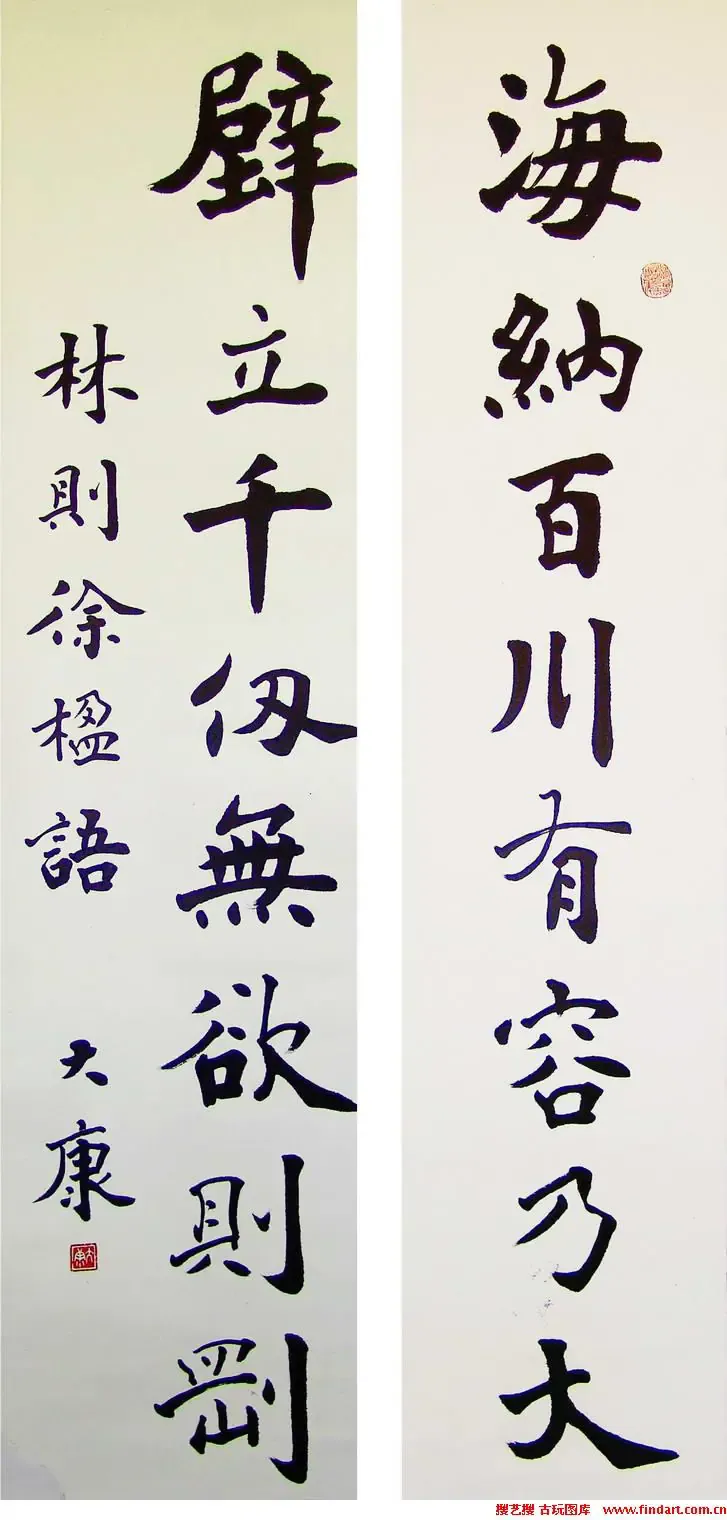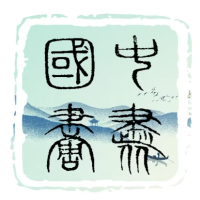康殷,号大康,著名古文字学、金石学、书画名家,教育家。
Kang Yin, known as Da Kang, is a renowned scholar in ancient Chinese script, epigraphy, painting, and calligraphy. He is also a respected educator.

康君博学广闻,遍涉甲骨、钟鼎、碑石、秦篆之学,造诣精深,著作丰盈。其书法篆刻,雄肆豪放,气韵生动,古意盎然。康君授徒,每当堂挥毫示范,用笔生涩凝重,勾划间笔锋变幻,行笔舒缓,法度严谨,观其书作,如刀走神工,令人叹为观止。君为人诚恳谦和,待学生循循善诱,费心教导,仁慈忠厚,为人师表。
康殷生于没落书香世家,家学渊源,幼嗜书画。四岁学书,后攻篆刻、绘画,十七岁入吉林师范大学绘画系,然不堪忍受日寇奴化教育,遂休学。中年潜心古文字字形研究。康殷一生坎坷,解放前穷困潦倒,“十年动乱”时遭囚“牛棚”,然对古文字、书法、绘画之研究未尝一日停歇。三中全会后,得任教于北京师范学院。每谈及此段历史,康君常激动言:“正道政策赐我第二次艺术生命。巳逾花甲,愿将毕生学术奉献伟大中华,留予后世。”
康殷学书,自六朝楷书入手,一生临摹诸多书体碑帖,曾得徐悲鸿、王道源、容庚、商承祚、钱瘦铁、邓散木等前辈鼓励。终生不懈探索实践,锤炼提高,形成“笔墨饱满、雄浑高古”之书法风格。正、草、隶、篆皆工,尤以篆书为最。其楷书笃实庄重,行书遒劲纵逸,隶书古朴险绝,鸟兽篆精巧细腻、缠绵婉转,篆大苍古浑厚、豪放洒脱,书界共称道焉。
Kang is widely knowledgeable, delving deeply into studies of oracle bones, bronze inscriptions, stone tablets, and Qin Dynasty scripts. His achievements are profound, and his works are numerous. His calligraphy and seal carving are bold and vigorous, full of life and ancient charm. When teaching, Kang often demonstrates his techniques in, using a firm and heavy brush, with changes in brushstrokes and smooth, slow movements, maintaining strict discipline. Observing his works is like witnessing divine craftsmanship, leaving one in awe. He is sincere and modest, guiding his students patiently and diligently, embodying kindness and integrity as a role model teacher.
Kang was born into a declining scholarly family, with a rich family heritage and a passion for painting and calligraphy from a young age. He began learning calligraphy at four, later studying seal carving and painting. At seventeen, he entered the Jilin Normal University’s painting department but dropped out due to the oppressive Japanese education. In middle age, he focused on researching ancient Chinese script forms. Kang’s life was full of hardships; before liberation, he was destitute, and during the Cultural Revolution, he was imprisoned in a "cowshed" but never ceased his research in ancient scripts, calligraphy, and painting. After the Third Plenary Session, he was appointed to teach at Beijing Normal University. Reflecting on this period, Kang often emotionally remarked, “The righteous policies gave me a second artistic life. Now past sixty, I wish to dedicate my lifetime of scholarship to great China, leaving it for future generations.”
Kang's study of calligraphy began with the regular script of the Six Dynasties. Throughout his life, he copied many different styles of calligraphy from various stele inscriptions, receiving encouragement from masters like Xu Beihong, Wang Daoyuan, Rong Geng, Shang Chengzuo, Qian Shoutie, and Deng Sanmu. He relentlessly explored and practiced, continuously refining his skills to develop a calligraphy style characterized by full, vigorous strokes and ancient grandeur. He excelled in regular script, cursive, clerical script, and seal script, with a particular mastery in seal script. His regular script is solid and dignified, his running script is strong and free, his clerical script is ancient and robust, his bird-and-beast seal script is intricate and fluid, and his large seal script is grand, bold, and unrestrained, earning high praise in the calligraphy community.
康殷为人忠厚鲤直,敢于直言。对友披心示诚,对晚辈循循善诱。重视书法传统,强调“法”之地位,反对狂怪。主张创新须在继承基础上,历经探索,自然变化。解放思想,独立思考,敢走前人未行之路,方能出新水平。曾作《论书》诗:“古人下笔已绝论,更有刀工妙入神。造化千秋钟异彩,我于此处悟天人。”乃其治学写照。
康殷谓,篆书须学古文字,明构造规律,随研究深入,改正旧误,不因热潮敷衍。赞同白石老人言:“学我者病,似我者死。”告诫后学,学书学古,临摹名迹,参考近人。精选性情相合之碑帖,亦可选相反范本,以矫正不足。博观古今,方能事半功倍。
康殷居北平时,先于怀柔为小学教员。日教书,闲则画画、刻印,临石鼓文。俭省用度,积粮换钞,求学北平。在徐悲鸿助力下,得旁听北平艺专。为糊口,兼任小学美术教员,摆摊刻字,研习书法篆刻。己丑(1949年),北平解放,康殷随南下干部队伍赴广州,任广州市图书馆馆长。其间,刻苦钻研古代美术,专注油画、国画、雕塑,发表诸多作品。
Kang is honest and straightforward, not afraid to speak his mind. He is sincere with friends and patiently guides younger generations. He values the traditions of calligraphy, emphasizing the importance of "rules" and opposing bizarre deviations. He advocates that innovation must be built on the foundation of inheritance, achieved through exploration and natural evolution. Embracing open-mindedness, independent thinking, and daring to tread uncharted paths are key to reaching new heights. He once wrote a poem on calligraphy: "The ancients’ strokes are beyond critique, more so are the miraculous cuts of the blade. Nature’s brilliance endures through the ages; here I comprehend the essence of heaven and man." This reflects his scholarly approach.
Kang asserts that learning seal script requires studying ancient scripts and understanding their construction rules. As research deepens, past errors must be corrected, without being swayed by trends. He agrees with Qi Baishi’s saying: "Those who learn from me are harmed, those who resemble me die." He advises younger generations to learn calligraphy and ancient scripts, to copy famous works, and to refer to contemporary works. Selecting stele inscriptions that match one’s temperament, as well as choosing contrasting examples to correct deficiencies, is crucial. A broad observation of ancient and modern works leads to more effective learning.
While living in Beiping, Kang first worked as a primary school teacher in Huairou. He taught during the day and painted, carved seals, and practiced the Stone Drum Script in his spare time. Living frugally, he saved up to study in Beiping. With Xu Beihong’s assistance, he was allowed to audites at the Beiping Art Academy. To make a living, he also worked as an art teacher at a primary school, set up a stall to carve characters, and studied calligraphy and seal carving. In 1949, when Beiping was liberated, Kang followed the cadre team south to Guangzhou and became the director of the Guangzhou Library. During this time, he diligently studied ancient art, focusing on oil painting, traditional Chinese painting, and sculpture, publishing numerous works.
















戊戌(1958年),康殷辞职返京,与夫人居香山之坡,生活艰难。康殷全身心投入学术与艺术,不辍写生作画,研金石古文字,苦练书法。与包狷叟、邓散木等名家切磋,编辑古印字书《印典》。数年辛劳,积十余万印拓卡片,写出厚重稿子。《印典》初稿成于“文革”前夕。丁卯(1987年),历经康氏夫妇32年心血,首册《印典》出版,癸酉(1993年)底全书四册出齐,共3000余页。此书为古玺印权威之作,提供珍贵资料,轰动国内外学界。
康殷书法以篆为主,篆类繁多。其甲骨篆融北方乡土气息与殷墟文字神韵,雄肆豪放,成“康体甲骨”之风。钟鼎金文雄骏方劲,浑厚圆活,端庄雍容,显商周书体演变痕迹。康殷之“石鼓文体”圆内见方,稳中见活,开新时代小篆新路。用笔涩滑疾徐,墨色枯润轻重,金石气韵提升至空前。其鸟虫篆勾画宛转,美不胜言,若鬼斧神工。隶书朴拙凝重,飘逸飞动,熔汉碑、简牍于一炉。楷书取法北朝楷,融魏之豪放与隋唐之规整,成“康家体”。行书遒劲纵逸,多变有法,破千年“中锋”之说。草书晚学,笔道如枯藤曲铁,重而空灵。篆刻独具一格,成“康氏金石”。笔刀并用,篆刻作品既有金石气韵,又不失毛笔意趣。其治印作品雄肆豪放,苍古浑厚,独步印坛,享誉海内外。
康殷兼中西画风,国画取法六朝唐宋,内容多为传统传说故事,章法严谨,笔墨踏实,古色古香。其早年出版《杜甫传》《李时珍传》等连环画,以绘事养生。康殷亦擅雕塑,能为人造泥像、木雕,形象逼真。精于颖拓,毛笔宣纸绘碑拓,效果逼真。其辨古画、古器能力独到,临摹汉代漆器画,宛如古器拓本。其在古文字研究中,以画家敏锐观察,解决众多疑难问题,自成体系,提供新史料。善诗词,古雅深沉,杜甫风范。文革期间诗稿多焚毁,实为遗憾。康殷熟谙诸子百家、经史、戏曲,尤爱昆剧,生活中善“杂技百工”,巧手成之。
康殷之能与成,常人得其一,已为学富五斗之名流。康殷却兼而有之,自述:“古文字研究为主,古印玺次之,书法、篆刻、绘画、考古、漆器研究,以及经史、诸子、诗词、戏曲、杂技百工,第三种以下,皆余事。”
In 1958, Kang resigned and returned to Beijing, living a difficult life with his wife on the slopes of Xiangshan. He devoted himself entirely to his scholarship and art, continuing to sketch, paint, study ancient inscriptions, and practice calligraphy. Collaborating with renowned artists like Bao Juansou and Deng Sanmu, he edited the ancient seal script book "Yindian." After years of hard work, accumulating over 100,000 seal impressions and producing a substantial manuscript, the initial draft of "Yindian" was completed on the eve of the Cultural Revolution. In 1987, after 32 years of effort by Kang and his wife, the first volume of "Yindian" was published. By the end of 1993, all four volumes, totaling over 3,000 pages, were completed. This book is an authoritative work on ancient seals, providing valuable information and causing a sensation in academic circles both domestically and internationally.
Kang's calligraphy mainly focuses on seal script, with many variations. His oracle bone script combines the rural atmosphere of the north with the spirit of the Yin Ruins characters, bold and vigorous, forming the "Kang-style Oracle Bone Script." His bronze inscriptions are majestic and robust, thick and round, dignified and graceful, showing traces of the evolution of script from the Shang and Zhou dynasties. Kang's "Stone Drum Script" is round within square, steady yet lively, pioneering a new path for the small seal script of the modern era. His brushwork is rough and smooth, with varying speeds, and his ink tones are light and heavy, elevating the spirit of inscriptions to an unprecedented level. His bird-and-insect script is intricate and fluid, stunningly beautiful, like divine craftsmanship. His clerical script is simple and solid, yet elegant and dynamic, blending the style of Han stele inscriptions and bamboo slips. His regular script is based on the Northern Dynasties' style, combining the boldness of the Wei dynasty with the regularity of the Sui and Tang dynasties, forming the "Kang Family Style." His running script is strong and free, varied and disciplined, breaking the thousand-year "centered brush" convention. His cursive script, learned later in life, is as if drawn with withered vines and twisted iron, heavy yet ethereal. His seal carving is unique, forming the "Kang's Epigraphy." Using both brush and knife, his seal carving works possess the spirit of inscriptions and the charm of brush strokes. His seal carving works are bold and vigorous, ancient and robust, standing out in the seal carving community and gaining international acclaim.
Kang's art combines Chinese and Western styles. His traditional Chinese paintings follow the styles of the Six Dynasties, Tang, and Song, mostly depicting traditional legends and stories, with rigorous composition, solid brushwork, and an ancient charm. In his early years, he published illustrated books like "The Biography of Du Fu" and "The Biography of Li Shizhen," making a living through his art. Kang is also skilled in sculpture, capable of creating lifelike clay and wood sculptures. He excels in ink rubbing, creating realistic reproductions of stele rubbings with brush and rice paper. His ability to identify ancient paintings and artifacts is unique, able to replicate Han dynasty lacquer paintings as if they were original artifacts. In his research on ancient scripts, his keen observation as an artist solved many complex problems, forming a unique system and providing new historical materials. He is skilled in poetry, with an ancient and profound style reminiscent of Du Fu. Unfortunately, many of his poems were destroyed during the Cultural Revolution. Kang is well-versed in variousical texts, history, and drama, particularly fond of Kunqu opera, and is adept at various crafts, producing skillful works.
Kang's abilities and achievements are such that excelling in any one of them would already make one a prominent scholar. However, Kang excels in all of them. He described himself: "Research in ancient scripts is my primary focus, followed by ancient seals, calligraphy, seal carving, painting, archaeology, lacquerware studies, as well asics, history, various philosophies, poetry, drama, and various crafts, all of which are secondary pursuits."
责任编辑:苗君
